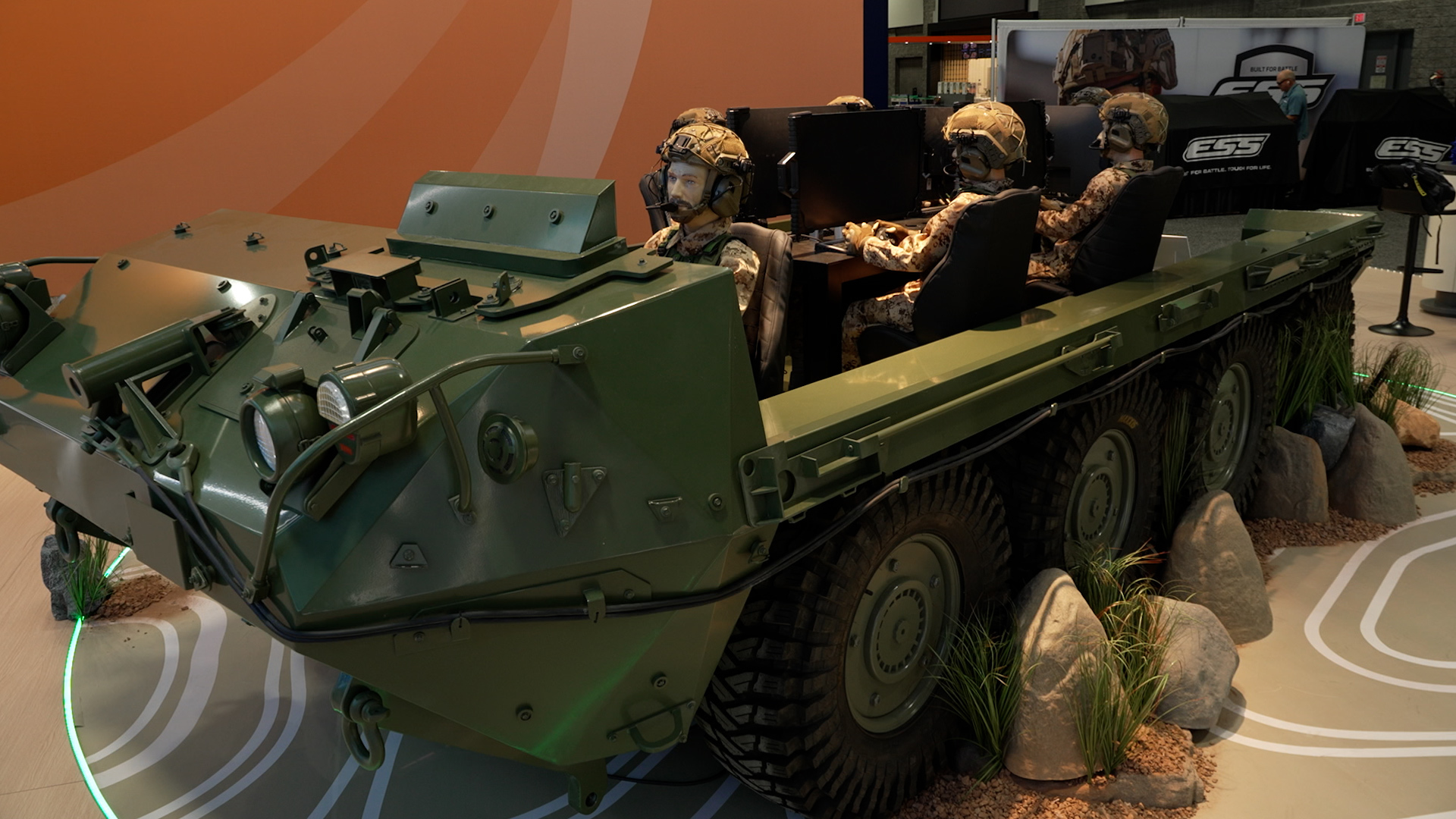
[Ryan Robertson]
BACK IN DECEMBER WE REPORTED ON UKRAINE’S USE OF AN ALL-DRONE GROUND ATTACK FORCE IN AN HISTORIC OPERATION THAT TOOK PLACE NEAR THE VILLAGE OF LYPTSI IN UKRAINE’S KHARKIV REGION. IT MARKED A FIRST IN THE HISTORY OF WARFARE. AN ALL-UNMANNED GROUND ATTACK TEAM TOOK ON AND COMPLETED A MISSION AGAINST RUSSIAN FORCES.
WHILE MUCH OF THE WORLD IS WATCHING AND LEARNING FROM UKRAINE’S EFFORTS IN EXPELLING RUSSIA FROM INSIDE THEIR BORDERS, THEY AREN’T THE ONLY ONES MAKING HEADWAY IN THIS TYPE OF COMBAT.
ISRAEL AEROSPACE INDUSTRIES, ALSO KNOWN AS I-A-I, IS ALSO MAKING STRIDES IN THE AREA OF UNMANNED COMBAT. AND THAT’S THE SUBJECT OF THIS WEEK’S DEBRIEF.
OVER THE COURSE OF MORE THAN SEVEN DECADES, ISRAEL AEROSPACE
INDUSTRIES HAS BECOME ONE OF THE LARGEST DEFENSE CONTRACTORS IN THE WORLD. RECOGNIZED FOR THEIR INNOVATIVE SOLUTIONS AND CUTTING-EDGE TECH, ESPECIALLY IN MISSILE DEFENSE, RADAR AND SENSOR SYSTEMS, AS WELL AS SATELLITE COMMUNICATIONS, THEY HAVE PLAYED A LARGE ROLE IN THE IDF’S EFFORTS TO PROTECT THE LIVES OF MORE THAN NINE MILLION ISRAELIS.
AND, MUCH LIKE UKRAINE, IAI IS DEVELOPING NEW AUTONOMOUS CAPABILITIES PAIRED WITH MANNED COMBAT SYSTEMS TO ALLOW SMALLER FORCES TO DO MORE WITH THE RESOURCES THEY HAVE.
[Amir Geva, Exec. VP of North American Affairs, IAI]
“A few years ago, the IDF launched two programs. One is the Carmel. Carmel is equivalent to the next generation Combat Vehicle program that runs here in the United States. And I is leading this program for the IDF for the Israeli Defense Forces. In parallel. Two years ago, the IDF, the idea of also launched a program called soy, which is stand off in allow the fight the troops to fight with from a standoff like they are standing in in those two programs, and the technologies that involved are robotics, technologies, AI And machine learning.
[Ryan Robertson]
UNDER THE CARMEL PROGRAM, IAI PURSUED FIVE KEY CAPABILITIES:
- Autonomous Mission Planning, Management, and Decision support
- Advanced, Hemispheric Situational Awareness, and Targeting
- Autonomous Lethality with Organic Effectors
- Autonomous Mobility
- Autonomous Control of Aerial and Ground Robotic Vehicles (Agents)
IN 2019, THE ISRAEL MINISTRY OF DEFENSE’S R&D DIRECTORATE LOOKED INTO HOW AUTOMATION AND MISSION AUTONOMY COULD BOOST THE EFFECTIVENESS OF MANNED CREWS. THAT LED TO IAI’S ELTA SYSTEMS GROUP INTRODUCING THE CARMEL DEMONSTRATOR, WHICH ALLOWED JUST TWO CREW MEMBERS TO TACKLE COMPLEX COMBAT MISSIONS THAT USUALLY WOULD NEED MULTIPLE VEHICLES AND THREE OR FOUR CREW MEMBERS.
[Ryan Robertson]
AMIR GEVA IS THE EXECUTIVE VICE PRESIDENT OF NORTH AMERICAN AFFAIRS FOR IAI. HE TELLS US THEIR EFFORTS HAVE BEEN DEVELOPED TO THE POINT WHERE THE IDF HAS BEEN ABLE TO CARRY OUT SOME MISSIONS IN THEIR WAR WITH HAMAS WITH SOME ROBOTIC ASSISTANCE.
[Amir Geva, Exec. VP of North American Affairs, IAI]
“And in the current conflict, this is what they do. They carry out robotic combat mission, mainly concentrating on life saving missions such as bridging, opening path, mine, clearing, countering IED, I need to emphasize always operator men in the loop, involved.”
[Ryan Robertson]
AT LAST YEAR’S AUSA GATHERING IN WASHINGTON D.C., IAI UNVEILED THIS “ROBOTIC WINGMAN” ON AN EIGHT-WHEELED VEHICLE THAT DEMONSTRATED THE STANDOFF CAPABILITIES OF THE CONCEPT. ALLOWING OPERATORS TO WORK AT A SAFER DISTANCE FROM THE ACTION THAN THEY MIGHT HAVE PREVIOUSLY. GEVA SAYS THE SYSTEM ITSELF WILL WORK WITH WHATEVER PLATFORM U.S FORCES CHOOSE TO INSTALL IT ON.
[Amir Geva, Exec. VP of North American Affairs, IAI]
“We are agnostic to the vehicle, as you saw, okay, we in previous we took this kind of a vehicle, but we are agnostic to the vehicle. We are providing the technology that might be on any any given technology depends on the customer, depends on the on the on the each one of the services is one of the army, which vehicle they will they will prefer. So this is the reason we choose this one. We are not providing the platform. We are providing the technology that will provide those robotics and tools that will allow to implement this kind of autonomous capability ”
[Ryan Robertson]
WHILE GEVA ADMITS THE SYSTEM IS NOT YET WHERE IAI ENVISIONS IT EVENTUALLY GOING, IT HAS PROVEN ITS WORTH IN ISRAEL’S WAR AGAINST HAMAS.
[Amir Geva, Exec. VP of North American Affairs, IAI]
“Right now, we’re concentrating on life saving missions. As I mentioned, are many. There are open paths, breaching, countering ideas, advanced guard missions. The future might be others not. It’s not our way to decide. Eventually, technology provide all what I mentioned, the operator might do that, and there are several people operating that, because eventually in the battlefield, there are more than one or one path to open. So this is the reason there are more than one operator.”
[Ryan Robertson]
THERE’S NO WORD FROM IAI ON ANY PENDING DEALS WITH THE DOD AS OF YET. IF AND WHEN THAT CHANGES, WE’LL LET YOU KNOW.











